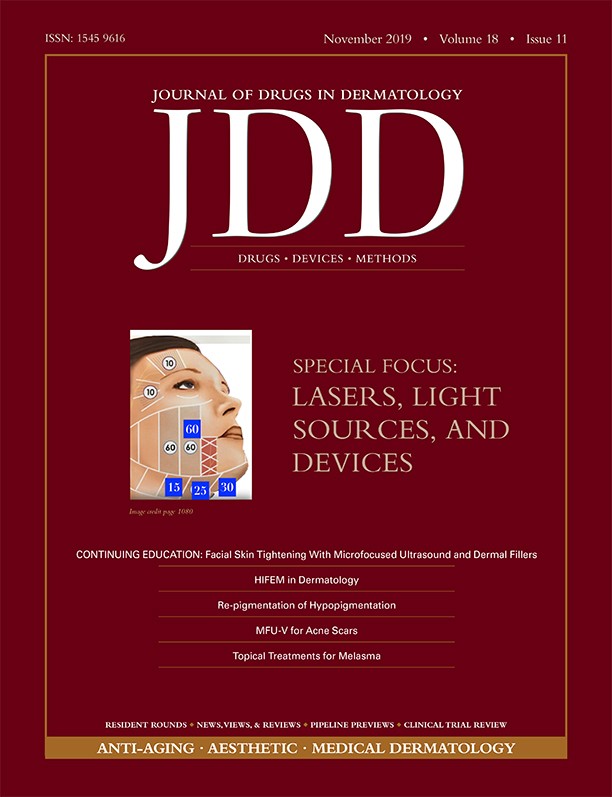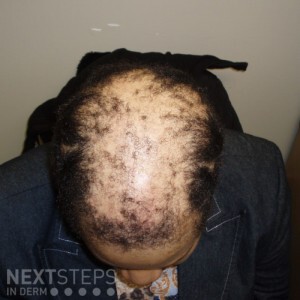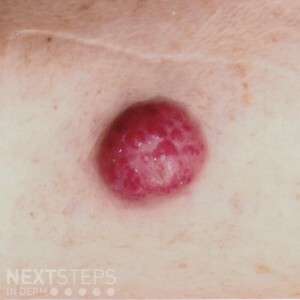JDD November Issue
 Here are the highlights for the November issue of JDD, which has a special focus on lasers, light sources, and devices.
Facial Skin Tightening With Microfocused Ultrasound and Dermal Fillers: Considerations for Patient Selection and Outcomes reviews of the application of microfocused ultrasound in combination with injectable dermal fillers as a treatment approach for lifting skin on the neck and …
Here are the highlights for the November issue of JDD, which has a special focus on lasers, light sources, and devices.
Facial Skin Tightening With Microfocused Ultrasound and Dermal Fillers: Considerations for Patient Selection and Outcomes reviews of the application of microfocused ultrasound in combination with injectable dermal fillers as a treatment approach for lifting skin on the neck and …
 Here are the highlights for the November issue of JDD, which has a special focus on lasers, light sources, and devices.
Facial Skin Tightening With Microfocused Ultrasound and Dermal Fillers: Considerations for Patient Selection and Outcomes reviews of the application of microfocused ultrasound in combination with injectable dermal fillers as a treatment approach for lifting skin on the neck and …
Here are the highlights for the November issue of JDD, which has a special focus on lasers, light sources, and devices.
Facial Skin Tightening With Microfocused Ultrasound and Dermal Fillers: Considerations for Patient Selection and Outcomes reviews of the application of microfocused ultrasound in combination with injectable dermal fillers as a treatment approach for lifting skin on the neck and … 

 The best diagnosis of this type of cicatricial alopecia shown in this image is:
A. Chronic cutaneous lupus erythematosus.
B. Lichen planopilaris
C. Central centrifugal cicatricial alopecia
D. Pseudopelade of Brocq
E. Alopecia mucinosa
To find out the correct answer and read the explanation, click here.
Brought to you by our brand partner Derm In-Review
…
The best diagnosis of this type of cicatricial alopecia shown in this image is:
A. Chronic cutaneous lupus erythematosus.
B. Lichen planopilaris
C. Central centrifugal cicatricial alopecia
D. Pseudopelade of Brocq
E. Alopecia mucinosa
To find out the correct answer and read the explanation, click here.
Brought to you by our brand partner Derm In-Review
…  Each month the JDD Podcast discusses a current issue in dermatology. During the month of September, podcast host Dr. Adam Friedman sat down with Dr. Andrew Alexis, Chair of Dermatology at Mt. Sinai St. Lukes and Mount Sinai West to discuss misconceptions regarding the aesthetic skin of color consumer.
Dr. Angela Hou, PGY-3 dermatology resident at George Washington University School of Medicine …
Each month the JDD Podcast discusses a current issue in dermatology. During the month of September, podcast host Dr. Adam Friedman sat down with Dr. Andrew Alexis, Chair of Dermatology at Mt. Sinai St. Lukes and Mount Sinai West to discuss misconceptions regarding the aesthetic skin of color consumer.
Dr. Angela Hou, PGY-3 dermatology resident at George Washington University School of Medicine …  Morbihan Disease (MD) is a rare condition but can be a very rewarding diagnosis to make. I interviewed Dr. Kimberly Huerth on her poster presentation of an African-American man with long-standing, progressive Morbihan Disease that took 16 years to diagnose. MD in patients of skin of color may be underreported as well as underdiagnosed. Similarly, rosacea in skin of color is often overlooked and th …
Morbihan Disease (MD) is a rare condition but can be a very rewarding diagnosis to make. I interviewed Dr. Kimberly Huerth on her poster presentation of an African-American man with long-standing, progressive Morbihan Disease that took 16 years to diagnose. MD in patients of skin of color may be underreported as well as underdiagnosed. Similarly, rosacea in skin of color is often overlooked and th …  Biopsy of this lesion reveals a poorly-defined dermal mass of small blue monomorphic round cells with scant cytoplasm and nuclear molding. Which histologic stain is most helpful in distinguishing this lesion from small cell lung carcinoma?
A. CK20
B. TTF-1
C. Chromogranin
D. Synaptophysin
E. Somatostatin
To find out the correct answer and read the explanation, click here.
Brou …
Biopsy of this lesion reveals a poorly-defined dermal mass of small blue monomorphic round cells with scant cytoplasm and nuclear molding. Which histologic stain is most helpful in distinguishing this lesion from small cell lung carcinoma?
A. CK20
B. TTF-1
C. Chromogranin
D. Synaptophysin
E. Somatostatin
To find out the correct answer and read the explanation, click here.
Brou …